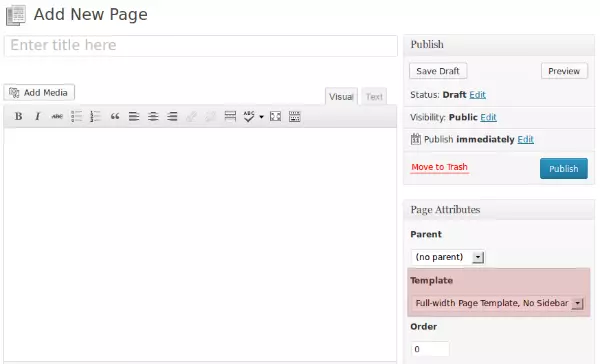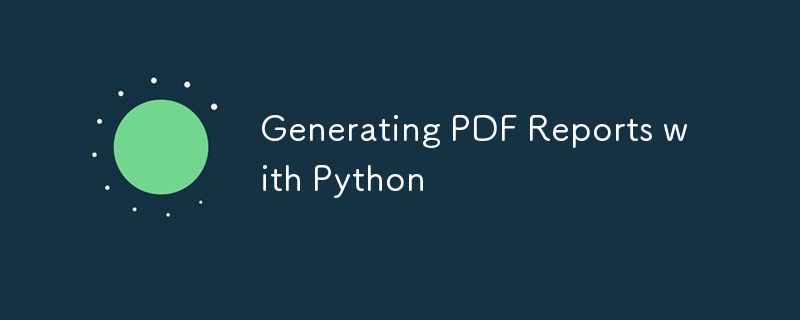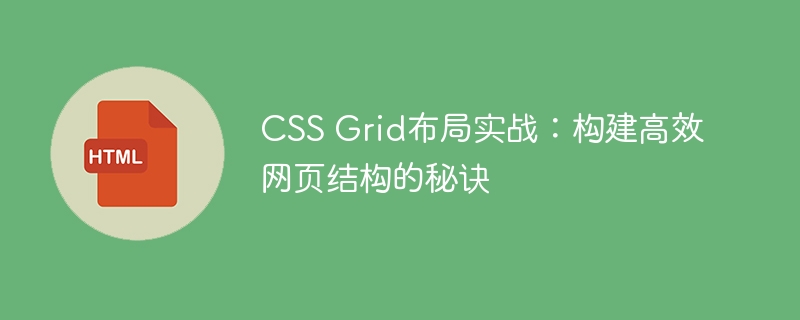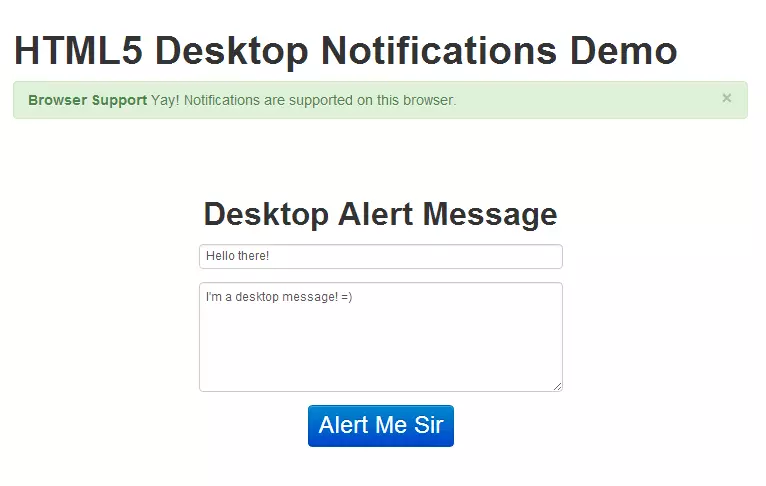Found a total of 10000 related content

How to learn HTML5 from scratch?
Article Introduction:The key to learning HTML5 is to start with the basics and learn while practicing. 1. First master the basic HTML structure, including, and tags, and practice writing simple pages through the editor; 2. Familiar with semantic tags such as,,,, and to improve web page readability and SEO; 3. Consolidate knowledge through small projects, such as creating resume pages or blog homepages, and combine CSS to beautify styles; 4. Learn new HTML5 functions, such as enhanced forms, multimedia support and Canvas drawing, and gradually expand skills. As long as you stick to practice, you can master HTML5 solidly and build a complete web page with CSS and JS.
2025-07-12
comment 0
876

How to Create Custom Template Tags in Django?
Article Introduction:Django template tags: simplify data display and improve code reusability
In Django development, templates are used to dynamically render data into HTML pages. This article will introduce how to use Django template tags to simplify data display logic and avoid duplicating code in views.
Django template basic example
Let's say you have a simple course list HTML template:
The corresponding view code is as follows:
The view passes the course data to the template, which is ultimately displayed on the web page like this:
Question: Show total number of courses
Now, let's say you need to display the total number of courses on a web page. One way is to add calculation logic in the view:
def course_list(request):
to
2025-01-27
comment 0
823

Use Go templates to display data in structures in GAE (using slices)
Article Introduction:This article describes how to use template engine template.Execute in Google App Engine (GAE) Go applications to display data in a structure. Since the container/vector package has been deprecated, it is recommended to use slices to store data. This article will demonstrate how to define a structure containing slices and pass it to a template for rendering, and finally display the data on a web page.
2025-08-22
comment 0
963

HTML's Purpose: Enabling Web Browsers to Display Content
Article Introduction:The core purpose of HTML is to enable the browser to understand and display web content. 1. HTML defines the web page structure and content through tags, such as, to, etc. 2. HTML5 enhances multimedia support and introduces and tags. 3.HTML provides form elements to support user interaction. 4. Optimizing HTML code can improve web page performance, such as reducing HTTP requests and compressing HTML.
2025-05-03
comment 0
623

Using HTML5 Semantic Elements for Page Structure
Article Introduction:Using HTML5 semantic tags can improve web structure clarity, accessibility and SEO effects. 1. Semantic tags such as,,,, and make it easier for the machine to understand the page content; 2. Each tag has a clear purpose: used in the top area, wrap navigation links, include core content, display independent articles, group relevant content, place sidebars, and display bottom information; 3. Avoid abuse when using it, ensure that only one per page, avoid excessive nesting, reasonable use and in blocks. Mastering these key points can make the web page structure more standardized and practical.
2025-07-07
comment 0
1109

WordPress Page Design: Shortcodes v Page Templates
Article Introduction:WordPress Theme Customization: Comparison of Page Template and Short Code
With its powerful features and flexibility, WordPress dominates the field of web design. Many amazing page designs are derived from WordPress’s theme customization capabilities, and page templates and shortcodes play a key role. This article will explore these two technologies in depth to help you choose the one that best suits your needs.
Core points
WordPress mainly implements custom page design through page templates and short codes. Page templates are used to display categories, articles, and pages in the default topic; short codes are reusable code snippets that provide complex features and display options.
When you need to customize the entire page, you should be better
2025-02-20
comment 0
1098

The Building Blocks of H5 Code: Key Elements and Their Purpose
Article Introduction:Key elements of HTML5 include,,,,,, etc., which are used to build modern web pages. 1. Define the head content, 2. Used to navigate the link, 3. Represent the content of independent articles, 4. Organize the page content, 5. Display the sidebar content, 6. Define the footer, these elements enhance the structure and functionality of the web page.
2025-04-23
comment 0
960

What is the HTML5 Document Type Declaration and Character Encoding?
Article Introduction:HTML5 document type declaration and character encoding are the basis of web page development, which directly affects page display and parsing. 1. HTML5 uses a concise declaration document type, which must be located at the top of the file, otherwise the browser may enter "weird mode". 2. It is recommended to use UTF-8 character encoding and through settings to avoid garbled code problems and ensure multi-language support. 3. In actual development, the complete HTML5 structure should include lang attributes, introduce meta encoding as soon as possible, optional viewport settings, and DOCTYPE must be located in the first row.
2025-07-08
comment 0
578

Generating PDF Reports with Python
Article Introduction:The Python libraries that generate PDF reports include ReportLab, FPDF and WeasyPrint, each suitable for different scenarios; 1. ReportLab supports complex typesetting, suitable for high-quality documents; 2. FPDF is light and simple, suitable for quickly generating PDFs with simple structure; 3. WeasyPrint supports HTML/CSS to PDF, suitable for existing web page content; when writing data, you can insert the template line by line through the library or render the template with Jinja2; layout and style can be inserted through tables, fonts, colors and pictures; precautions include Chinese display, page layout, path issues and performance optimization.
2025-07-24
comment 0
981

How to create a simple single-page resume using HTML?
Article Introduction:To create an HTML single-page resume, the key is to have clear structure, concise style, responsive design and test release. 1. In terms of structure, use the header to place the name and contact information, section displays educational background, work experience, skills and other content in blocks, and footer can optionally place supplementary information; 2. Use appropriate font size (such as 16px), line height (1.5-1.6), color contrast and block spacing in the style to keep the page clean and easy to read; 3. Responsive design adjusts the font and layout through media query to ensure that the mobile phone display is good; 4. Finally, after local testing is correct, it can be uploaded to GitHubPages or Netlify for release, and the content is updated regularly to keep the latest.
2025-07-16
comment 0
237

How You Can Use HTML5 Custom Data Attributes and Why
Article Introduction:HTML5 custom data attributes allow developers to store custom data in HTML elements. They provide a way to add additional information to HTML elements that can be used by JavaScript or CSS, thereby enhancing web page functionality. This article will explain what data attributes are and what they are for.
Key Points
HTML5 custom data attributes allow developers to store additional information on HTML elements that can be accessed and used by JavaScript or CSS, thereby enhancing web page functionality.
Data attributes always start with "data-", can be used to style elements in CSS through attribute selectors, and can display information to users through the attr() function.
In Java
2025-02-17
comment 0
1022

CSS Grid layout practice: The secret to building an efficient web structure
Article Introduction:This tutorial explores in-depth how to use HTML and CSS Grid layouts to build efficient and responsive web structures. We will focus on the core properties of CSS Grid, such as display: grid and grid-template-areas, and demonstrate how to define grid areas through actual examples. At the same time, the importance of correct HTML tag closure for normal rendering of CSS Grid is emphasized, helping beginners avoid common mistakes and achieve the expected page layout effect.
2025-08-30
comment 0
737

What is the tag in HTML5?
Article Introduction:HTML5 tags are used to provide metadata of web pages, including setting character encoding, page description, keywords, author information, controlling mobile viewports, social sharing optimization and website theme colors. 1. Set character encoding (such as UTF-8) to avoid garbled code; 2. Provide page description and keywords to improve SEO; 3. Use viewport to control the mobile display effect; 4. Optimize social sharing preview through OpenGraph or TwitterCard tags; 5. Set theme-color to enhance brand recognition in the browser.
2025-07-18
comment 0
877

How to create a sub-label in Gmail
Article Introduction:Gmail implements a "sub-tag"-like structure through tag nesting. Operation steps: 1. Open the Gmail web version and enter the "General" tab page in "Settings"; 2. Click "New Tag" in the "Tags" section and enter the main tag name such as "Work"; 3. Click "New Tag" again and enter "Work/Project A", and the system will automatically recognize it as a sub-tag. When you type a tag to an email, add it manually on the email details page or automatically assign it through a filter. Management skills include: the main tag cannot be deleted directly, modifying the main tag name will affect the display name of the sub-tag. The mobile terminal expansion method is different, and it is recommended to plan the classification structure in advance.
2025-07-19
comment 0
652

Building a Basic Web Application with Flask Python
Article Introduction:Flask is a lightweight framework in Python suitable for quickly building web applications. 1. After installing Flask, create an app.py file as the main program; 2. Write code to implement the "HelloWorld" page, access the local server to view the effect by running scripts; 3. Add multiple static pages or use dynamic routing to support variable delivery; 4. Use the Jinja2 template engine to render HTML pages and realize dynamic content display. The entire process gradually expands from basic examples to multi-page applications, reflecting Flask's flexibility and ease of use.
2025-07-07
comment 0
473

What is the canvas element in HTML5?
Article Introduction:The HTML5 element is a blank canvas for drawing graphics using JavaScript on a web page. It does not display anything by itself and must draw shapes, text, images and animations through scripts. To use, first add a tag with id, width and height in HTML; then get the element through document.getElementById() and call .getContext('2d') to get the drawing context; then draw the content using the context method. It can be used to draw shapes, render text, display images, create animations, and build games. It should be noted that canvas is based on pixels, lacks built-in event processing and barrier-free support, and performance is also affected by complexity.
2025-07-13
comment 0
351

HTML5 Desktop Notifications Example
Article Introduction:HTML5 desktop notification demonstration and detailed explanation
Hello everyone! Today I will show you how to implement desktop notifications using HTML5 and a small amount of JavaScript code through a simple demonstration. GitHub Project
HTML5 desktop reminder background information
Notifications allow users to be reminded outside the context of the web page, such as delivery of emails.
You can display, queue, and replace notifications. You can also add an icon to the message body on the left side that appears on the left side of the message body. You can also use tag members for multiple instantiation (the result of this case is a notification; the second notification replaces the first notification with the same tag). [Learn more about W3C Web
2025-02-24
comment 0
958

How to add an image to a webpage using HTML5?
Article Introduction:The core method of adding images to a web page is to use tags and match the necessary attributes. First, use self-closed tags, and specify the image path through the src attribute, and provide alternative text; second, click jump through the tag to wrap the image; second, use HTML5 new tags to display the image and title; in addition, you can set width, height or use CSS to control the image size, and use loading="lazy" to achieve lazy loading to optimize performance.
2025-07-27
comment 0
425

How to embed a PDF in an HTML5 page?
Article Introduction:If you want to display PDF files in web pages, HTML5 provides a practical way. 1. Use or tags to embed PDF directly, suitable for lightweight projects, but limited style control; 2. Advanced functions such as page turn and zooming can be realized through PDF.js, with good compatibility but requires front-end knowledge; 3. Use GoogleDocs preview service to be simple and fast, but there is privacy risk, and is suitable for non-sensitive documents. These three methods can be selected and used according to your needs.
2025-07-11
comment 0
257

How to use the audio element in HTML5?
Article Introduction:The HTML5 elements can directly embed audio on the web page. The basic syntax is to use the src attribute to specify the file and add controls display controls; 1. Common properties include controls, autoplay (often blocked), loop, muted and preload; 2. To be compatible with different browsers, multiple format audio should be provided with mp3 and ogg; 3. Custom control can be achieved through JavaScript calls to play(), pause() and control properties such as volume and currentTime; 4. Best practices include avoiding non-silent automatic playback, providing backup content, ensuring keyboard navigation, and adding aria-label to improve accessibility.
2025-08-20
comment 0
605



















